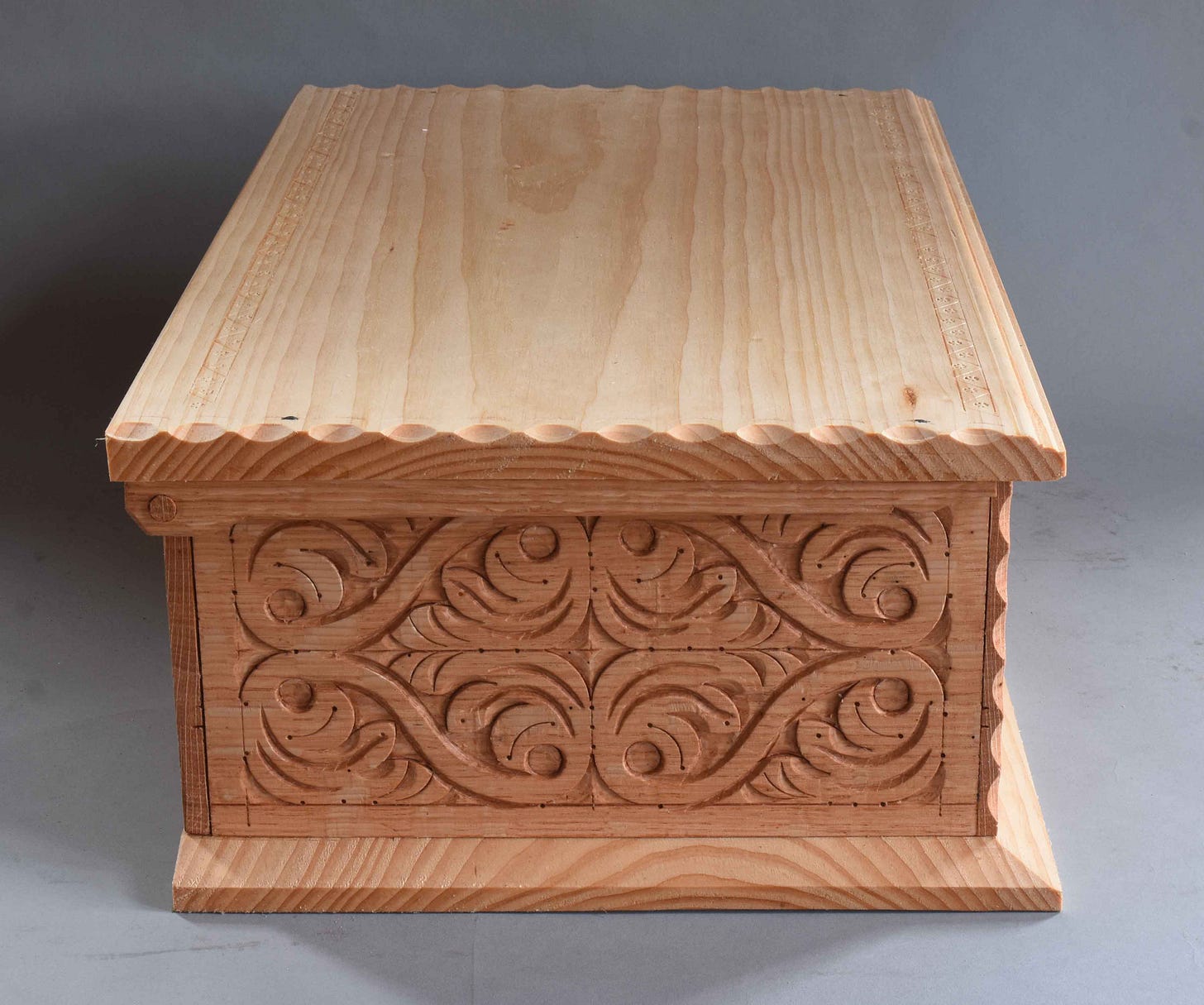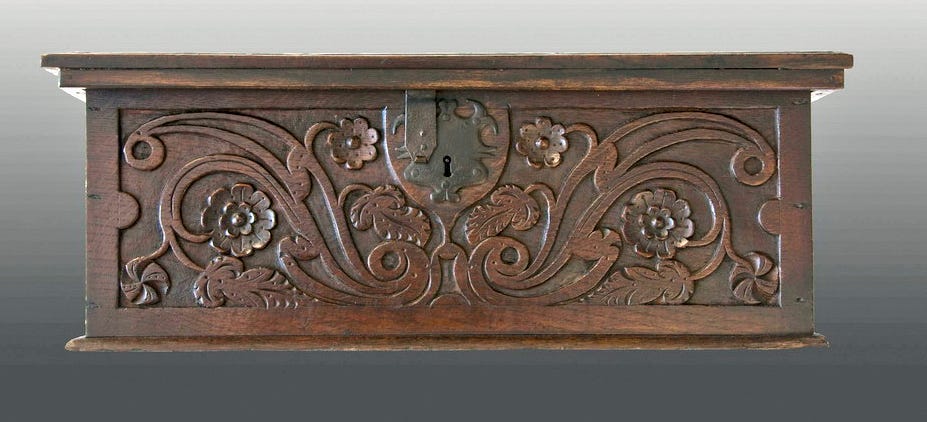[update: I no sooner posted this than the box sold. If you’re interested in getting a carved box, email me at PeterFollansbee7@gmail.com and I can put you on the list. I didn’t expect it to sell so quickly, so figured more people would have a chance.]
I finished a carved box this week - based on the carved work from Devon, England. It’s done, oiled & photographed - and now for sale. Details at the bottom of this post - but first I’ll show you some of the source material I use to make this box.
I sometimes make a direct copy of a period box, but most often make them like this one - where I draw ideas from more than one period box. The idea of using pine for the lids and bottoms is right out of New England examples - millsawn pine boards were commonly used, even on boxes made from riven oak boards. The pintle hinge I use most often comes from just a few boxes I’ve seen, including one made in Dedham Massachusetts, now at the Yale University Art Gallery. The rabbet joints in my usual boxes are glued and pegged - not nailed as is the most common fixing. I’ve seen a few pegged boxes - I do it as a matter of course. It saves my hand-made nails for where I really need them.
Now about the box and its inspiration. I've written here & elsewhere about the carved works from Devon, England and their relationship to the oak furniture attributed to Thomas Dennis & before him William Searle, of Ipswich, Massachusetts. Rather than repeat all that background, I’ll post a link to one of the earlier entries on this blog https://peterfollansbeejoinerswork.substack.com/p/more-strapwork-carvings?utm_source=publication-search
I’ve seen a number of the boxes and chests (and some church fittings) that are part of the broader group of Devon joinery. The first box I made when I began working at what was then called Plimoth Plantation 30 years ago was a copy of this one they owned. I removed the escutcheon - it was a replacement - screwed on. I wanted to see the pattern beneath. And it turned out to be a wide, empty space just right for an escutcheon.
At the time I was quite familiar with the New England versions, but didn’t even recognize this as Devon work. I remember spending a lot of time trying to understand how the pattern was laid out - arcs here, freehand there. I got the carving done, but one problem I had at that point is that I was too focused on a single example. Over time, I learned the benefit of gathering information about as large a group of related works as you can.
I’ve now collected images and notes on many of them - both the English ones and New England examples. Of the NE boxes, there’s maybe 15 that I know of and I’ve probably seen about half of them. Thankfully, these days you can often access museum collections online - and more and more of the collections are photographed and posted there.
There’s a few different formats for the carved boxes from these joiners - the ones I’m concerned with today are the patterns that are done free-hand - no geometry, no layout to speak of. They break down into two groups so far - the New England freehand ones, about 6 boxes so far - relate to some carved panels from the chests - An urn at the bottom center of the box front and a stalk/stem rising from it and branching out left and right. There’s almost no layout for this pattern - I scribe some rough limits to the urn - using a marking gauge and compass off of a vertical centerline and the bottom edge of the box front. To get the rest, I carve one half and try to then draw the same pattern as a mirror image. That notion frightens some people, but once you learn the “vocabulary” it works out fine.
And one of my versions of that design - copied from a related box.
The English/Devon boxes have a sub-group that features a different freehand pattern - this next one is from Paul Fitzsimmons’ Marhamchurch Antiques site. It relates to the Plimoth example above and several others, most of which I’ve seen through Fitzsimmons. https://www.marhamchurchantiques.com/
In this case, the urn is out the window - there’s just a series of sweeping curves emanating from a vertical middle - big leaves, flowers, pinwheels, etc. After seeing a few of them, you begin to recognize the options and concepts. Here’s another from Marhamchurch’s site - the same format as the one I based my new box on:
One way I got the hang of this pattern is to draw every version I saw, either in life or in photos. Easier to work out the lines on paper than on oak…
THE BOX CURRENTLY FOR SALE :
I only put locks on my boxes when a customer specifically orders a lock - so I substituted a tulip pattern, derived from related chests, to fill that middle space.
Riven oak with white pine lid and bottom. Lidded till inside.
H: 7 1/4” W: 21 1/4” D: 13”
Price is $1,500 plus shipping. Last one was $90 to ship to Maine from here in Massachusetts - so that might give you an idea on the cost. If you’d like to purchase it, send an email or leave a comment here and we can sort out the details. I can send a paypal invoice or we can go old-school and you can mail a check…













Great work. I’m interested. Kpatukas@Gmail.Com. Linseed oil finish?